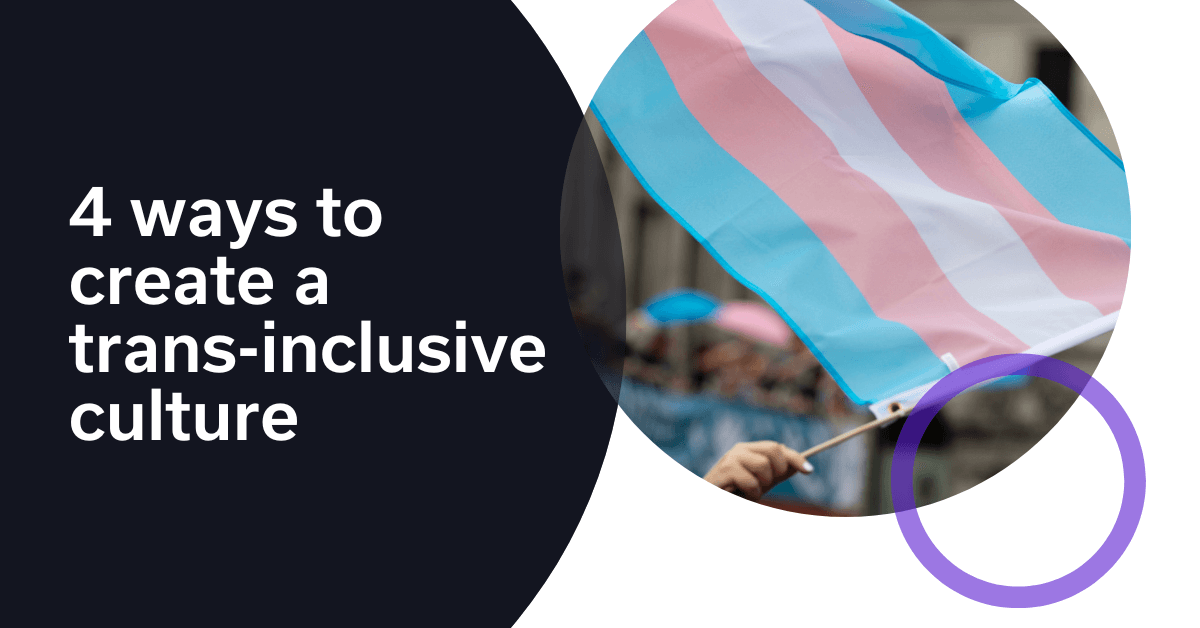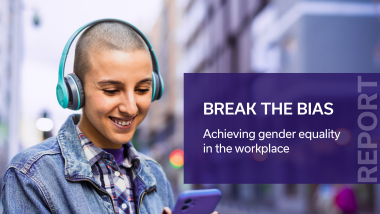4 ways to create a trans-inclusive culture
This Pride Month, we want to celebrate the transgender community around the world – especially our trans colleagues. Public awareness of trans people, the protections they require, and the diverse spectrum of gender identities that exist is at an all-time high. While it has been fantastic to see this progress take shape over the last decade, there’s still a lot of work to be done.
In the U.K. Equality Act 2010, transgender identities feature alongside eight other protected characteristics, and all employers and managers must consider how they can work preventively and reactively against discrimination and harassment of these groups. Yet a 2021 YouGov poll found that discrimination against trans people in the workplace is on the rise. Out of the 410 trans employees polled, 65% said they felt the need to hide their trans status at work – a ten-point increase since 2016. The study also revealed that 32% of trans employees had experienced discrimination in the workplace in the last five years.
Employers and HR teams have a responsibility to protect their workforce from bullying and discrimination in the workplace. Internally, highlighting your stance as a supportive, equal-opportunity employer will be deeply reassuring for your current queer and trans employees, and provide practical guidance for their colleagues.
Externally, referencing these policies in your job ads and careers marketing material can bolster your employer brand and attract top talent who share your company’s diversity and inclusion values – a recent study by Glassdoor revealed that 76% of active and passive job seekers employees consider a diverse workforce to be an important factor when evaluating companies and job offers.
The “transgender umbrella”
Transgender is widely recognised as an umbrella term for anyone who isn’t cisgender – which means anyone whose personal identity and gender corresponds with their birth sex.
It encompasses a multitude of gender identities, and includes binary trans people (trans men and trans women), as well as non-binary people (those who feel that their gender cannot be defined by the existing gender binary) and gender fluid people (those whose gender changes over time).
Here are four ways to create a more trans-inclusive culture at your company:
Learn about the trans experience
LGBTQ+ history and the modern-day experience are both rich and complex. While it’s great to show an interest in the perspectives of your trans employees, they shouldn’t be expected to educate you on queer and trans issues. Sometimes, doing your own research to optimise your existing processes can be the ultimate sign of solidarity. Fortunately, there are multitude of informative resources out there to help you improve your understanding, including Stonewall, Mermaids and Akt, to name just a few.
Promote trans-inclusive policies
Creating a trans-inclusive culture requires HR teams to put clear policies in place. These should cover the company’s anti-harassment and bullying policies and the company’s ED&I values, and include a dedicated trans-inclusive policy. It’s important to take an honest look at your existing policies and assess whether they’re comprehensive or if they need to be updated. Here are some factors to consider:
Gender transition guidelines
These guidelines should outline the responsibilities and expectations of transitioning employees, their managers, and co-workers.
All employees should be able to readily access these guidelines – for example, via your company’s intranet or Employee Assistance Programme (EAP) – so they can understand at a glance what they can expect from management, and who their main point of contact should be when managing their workplace transition.
Personnel records and data
Ensure your company has an efficient process for transitioning an employee's name and gender in all personnel and administrative records. These can include internal and external personnel directories, e-mail addresses and business cards.
Access to facilities
Regardless of what stage they’re at in their overall transition process, all employees should be able to use sex-segregated facilities, such as bathrooms and locker rooms, that correspond to their full-time gender presentation.
Dress codes
When implementing dress codes, make sure to avoid requirements that perpetuate gender stereotypes (requiring women to wear skirts, dresses or high heels). Dress codes should be applied consistently across your workforce. Transgender employees should feel able to dress consistently in accordance with their full-time gender presentation.
Health insurance
Gender-affirming treatments and procedures that are medically necessary should be included in your company’s healthcare and short-term disability coverage.
Hidden bias is often so embedded in workplace processes that it can be difficult to spot the patterns that may be occurring. Our award-winning Recruitment Inclusivity Audit is designed to take an in-depth look at an organisation’s recruitment practices, spanning seven Diversity & Inclusion lenses – age, ethnicity, disability and neurodiversity, LGBTQ+, age, socio-economic background, and faith – across 12 stages of the candidate journey. In order to enable organisations to action meaningful change, we provide an immediate to-do list with recommendations for minimising bias.
Respect pronouns
Pronouns are the words we use to refer to people in conversation. This can include the person speaking (“you” or “I”) or a person they are speaking about (“she”, “they”, “this”). Non-binary people often use the gender-neutral pronoun they/them.
Addressing an individual by their preferred pronoun is a basic sign of respect. All employees should have the opportunity to choose their gender identity and preferred pronoun. Ideally, this should be done at the onboarding stage.
In recent years, you’ve probably noticed that more and more people have included their pronouns in their email signatures and social media bios. This is a small action that can have a big impact. Not only it is an easy way for trans employees to clarify their preferred pronoun and communicate it across the company, but by encouraging cisgender colleagues to do the same thing, it signals that inclusivity is something your organisation takes seriously.
Allyship for all
An ally is someone who takes action to support an underrepresented group, despite not being a member of the group in question. There are a number of ways to cultivate a culture of allyship in your organisation, but it usually starts with the employer clearly communicating their supportive position, as well as enabling open and honest conversations with employees, especially those who belong to these minority groups.
If you offer equality, diversity and inclusion (ED&I) training to your employees, make sure to include material that covers gender identity and gender expression. Your workforce should be encouraged to speak up when they witness discriminatory behaviour, challenge microaggressions, and take the initiative to educate cisgender colleagues so their trans colleagues don’t have to do so.
Since launching in 2020, our Recruitment Inclusivity Audit has won several awards, including Innovation of the Year at the Firm Awards 2022 and the DE&I prize at the US TIARA Awards 2022. To find out more about our Recruitment Inclusivity Audit and how it can help you create a more inclusive hiring process, click here.













